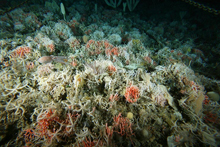News
New atlas of Southern Ocean marine life
Published:25 August 2014
New atlas of Southern Ocean marine life

Diverse hydrocoral, sponge and bryozoan
community within a shelf cutting canyon on
the East Antarctic margin. Photo credit:
Australian Antarctic Division.
A new marine biodiversity atlas that provides the most thorough audit ever of marine life in the Southern Ocean has distinct Australian links.
Leading marine geoscientists, biologists and oceanographers from all over the world, have spent the last four years compiling everything they know about marine life in the Southern Ocean and the environments that support this marine life.
Dr Alix Post from Geoscience Australia, author and editor of the environmental chapter, said the atlas is a great resource that provides a single point of call for accessing the latest information on Southern Ocean environments.
The new Biogeographic Atlas of the Southern Ocean, published by the Scientific Committee on Antarctic Research, includes a wide range of information from the dynamics of the surface waters, and distribution of sea ice, through to the shape and composition of the seafloor.
"The Atlas will support conservation efforts by allowing relevant environmental layers to be combined with known species occurrences, providing the basis for modelling the broader distribution of Southern Ocean species in areas that remain under-sampled," Dr Post added.
Geoscience Australia, in collaboration with the Australian Antarctic Division, contributes to ongoing international efforts to understand the unique and diverse assemblages of organisms that live in the Southern Ocean. This has included work obtaining physical datasets in East Antarctica and marine ecosystem studies in the Mertz Glacier region, off the coast of Antarctica to map and understand Antarctic seafloor environments.
The work undertaken by Geoscience Australia on the East Antarctic margin is a great example of where research is aiding management efforts in this region. A range of physical datasets collected and analysed by scientists at Geoscience Australia have contributed to the selection of a representative system of Marine Protected Areas for East Antarctica, which is currently under consideration by the Commission for the Conservation of Antarctic Living Resources.
The data, and expert opinions, in the new atlas will help to inform policy, and provide a baseline for assessing future change to Antarctic marine ecosystems.
Contact:
Phone:
Email:




